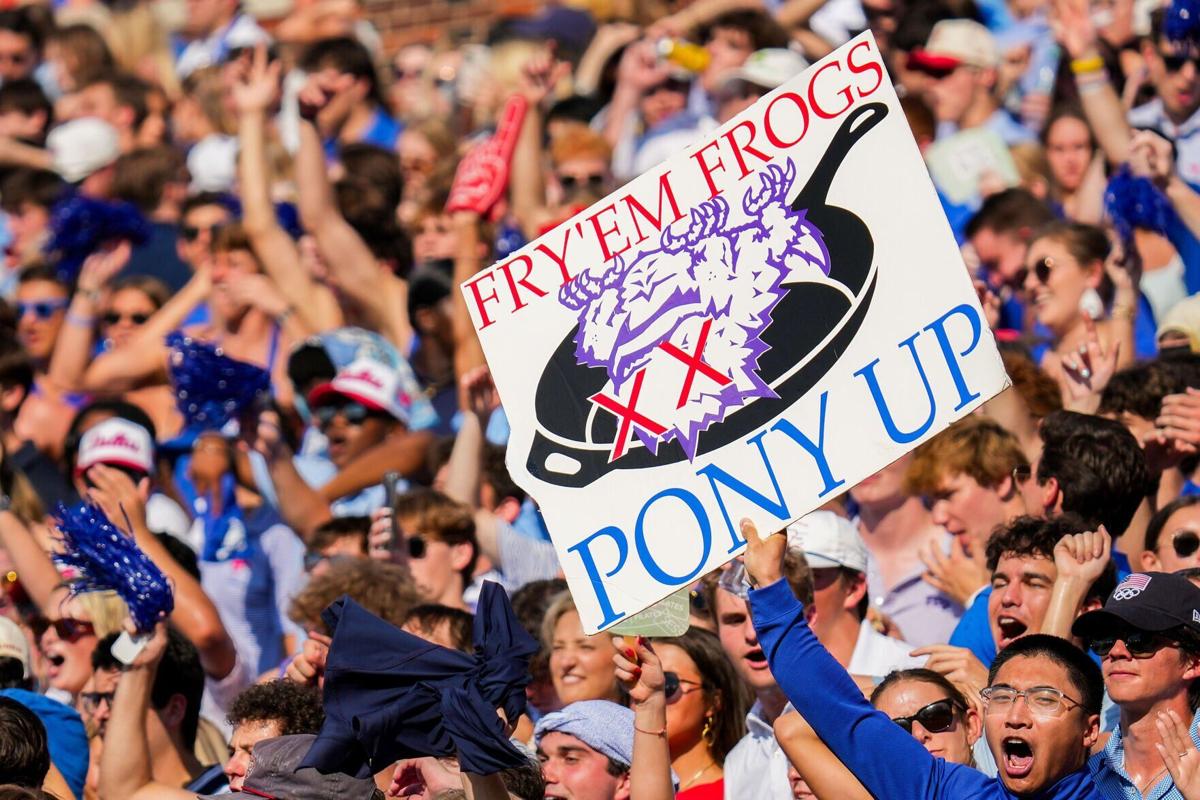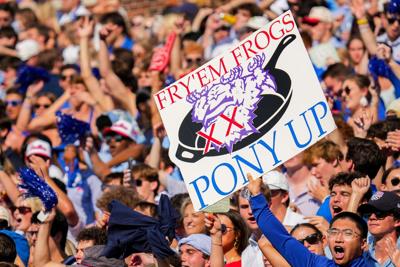DALLAS ã In this era of college athletics, there is no offseason.
Something is always changing, from realignment to the transfer portal to NIL.
But for athletic directors and departments across the nation, the start of the 2025 summer may have been their least relaxing yet.
Last month, Judge Claudia Wilken approved a $2.8 billion antitrust settlement that will allow universities to directly pay their athletes for the first time.
It was a monumental decision that provided guardrails in the world of name, image and likeness, which had become the free-for-all system for the last four years.
ãWhen it was signed, it was a sigh of relief for a little bit, and then we really got started on the work that needed to be done,ã TCU athletic director Mike Buddie said.
People are also reading…
Those payments from universities to their athletes began Tuesday, and while many colleges across the state and country have spent years preparing for the possibility of this change, they were left with just weeks to read the language of the settlement and enact their new protocols that fundamentally change the way theyãve operated.
The House settlement changes the way players can be paid, the amount they can be paid, the scholarship limits of rosters, the purpose of NIL collectives and, frankly, the entire NIL system.
Nearly all of Texasã 13 FBS programs have indicated an intention to change with the times, opting into the new system either by choice or mandate. Many athletic directors say theyãre operating in an era where they must adapt or be left behind.
ãWhen change happens to you that you didnãt instigate, you have a simple choice,ã Texas A&M athletic director Trev Alberts told reporters last week. ãYou either adjust and adapt and modernize to that approach, or you donãt. You never stay the same in college athletics. Youãre either getting better, or youãre falling behind.
ãI sense, in some respects, a sigh of relief. On the other [hand], is this really going to work?ã
The good: Some much-needed guardrails
Thereãs not much everyone in college athletics can agree upon, but four years after NIL went into place, the consensus was that it got out of hand.
On July 1, 2021, the NCAA adopted a policy that allowed student-athletes to profit from their name, image and likeness. What was intended to pave the way for third-party brand deals opened the door to collectives essentially buying rosters for their universityãs athletic programs with six- and seven-figure offers, particularly in football, menãs basketball and womenãs basketball.
ãI think, sadly, we got to a point where the only thing that seemed to matter was, ãwhoãs going to give me the most money?ã ã Buddie said.
Some top football programs spent between $35 million and $40 million dollars to construct a roster, according to multiple reports. The desire to be the best led to, in some instances, a heated bidding war and tampering with other programsã players.
But the House settlement provides some strict guidelines that prevent programs from running wild as they have for the last few seasons.
Programs that opt-in to revenue sharing with their athletes can spend a maximum of $20.5 million in the 2025-26 school year across all sports, according to the NCAA. That cap will increase by about 4% every year during the decade-long deal, ending at an estimated $32.9 million in 2034-35.
Those payments would be in addition to scholarships and other benefits athletes already receive, including their third-party NIL deals. However, any third-party deal worth more than $600 must be sent to a new clearinghouse called NIL Go, run by the consulting firm Deloitte, which will seek to regulate the market and prevent schools from circumventing the cap through external deals.
The goal is to level the playing field among all schools that choose to opt-in, while providing athletes with a share of the revenue that theyãve long been responsible for bringing in.
ãIf weãre successful with this new entity, coaches are going to go back to doing three things: recruiting, developing and coaching,ã Alberts said. ãWhat a novel concept. The last three years, theyãve been begging people for donor money to go buy, acquire and retain talent in their roster.ã
The bad: Uncertainty and tough decisions
Wilken signed the House settlement June 6, giving athletic directors just 25 days to prepare for the monumental change.
In that short time, endless decisions had to be made, and even with those payments beginning Tuesday, uncertainty still remains.
The first decision facing athletic directors was whether to opt into the settlement at all. Power conference schools had no choice but to take part in the new system, but the remaining schools from other conferences were given a choice.
In Texas, that means Texas, SMU, Baylor, TCU, Texas Tech, Texas A&M and Houston all opted in automatically. Texas State, UTSA, North Texas, Rice and UTEP all also made public statements expressing their commitment to doing so. Sam Houstonãs plan is still unclear.
While some schools and conferences like the Ivy League have chosen to opt out, most felt an obligation to opt in.
North Texas athletic director Jared Mosley said his schoolãs position in the American Athletic Conference just outside of power conferences almost requires them to opt in to remain competitive.
ãWe want to solidify our place in the Division I landscape, and so it was never an option for us to not opt in,ã he said.
Then, programs have to decide whether they plan to hit the $20.5 million cap. Power conference schools like SMU and TCU didnãt hesitate when asked whether theyãd hit that number. Many exceeded that threshold in the past, possibly even for football alone.
ãMake no mistake about it,ã SMU athletic director Damon Evans said. ãWeãre going the full $20.5 million, which we need to do. I want to make sure that we really continue to assess the marketplace and put the resources where they need to be in this revenue share to make sure that weãre highly competitive.ã
But most smaller programs likely wonãt. Mosley said he anticipates a range in the AAC in terms of revenue sharing, with some operating in the $12 million-15 million range and others like his program paying athletes between $2 million-6 million.
The decision on how much to spend also comes down to how athletic programs can account for the new $20.5 million expense. Many are dissolving their collectives and asking donors to instead contribute to their athletic programsã direct funds. Others will increase costs to fans through talent fees and raising concession prices.
UTSA, for example, met with the Dallas Cowboys last football season to better understand how they monetize and generate revenue from a business standpoint. UTSA athletic director Lisa Campos said from that meeting they developed a handful of strategies, including offering an option for fans to round up concessions prices to the nearest dollar to support UTSA student-athletes.
ãThis is becoming a more professional model,ã Campos said. ãWeãre going to pull a lot of different levels. Itãs going to be more fundraising, generating more ticket revenue. Thereãs going to be a lot of different levers that are being pulled to help generate these dollars.ã
From there, the toughest decisions come down to how to allocate those funds. Most are expected to go to football, menãs basketball and womenãs basketball ã the three sports that generate the most revenue ã at every institution.
Some schools like TCU are committing to sharing revenue with all of their athletes. Others like Texas A&M plan to limit revenue sharing to certain sports.
Texas A&M says it will share revenue with football, baseball, menãs and womenãs basketball, softball and volleyball. But Alberts says other sports will still benefit from the settlement through the roster limit piece in which schools will now be able to raise the number of scholarships in many of their sports.
ãAt the end of the day, most of this is a result of business thinking,ã Alberts said. ãWhere can we spend money in rev share to grow competitive success to drive additional revenue?ã
That thinking seems to be the standard for most schools now, but some worry it could get them in trouble later, especially if Title IX lawsuits are ultimately filed for an uneven distribution of revenue between menãs and womenãs programs.
ãYou get to choose your lawsuit,ã Buddie said. ãYou can distribute your rev share within the regulations of Title IX and wait for your football players to sue you, or you can disperse it, as outlined in the House settlement, and wait for the Title IX lawsuit.ã
The future: More regulations needed
Athletic directors anticipate needing to adjust year after year in this new era of college sports.
Evans said he doesnãt expect this first year to be fully reflective of the new system.
ãItãs going to be hard this first year because whatãs in the cap management system wonãt really accurately reflect what everybody got paid,ã he said. ãLetãs just be candid: we all frontloaded, so I donãt think weãll see the true numbers until the second iteration.ã
Many recruits brought in before July were paid by collectives up front, some for multiple years-worth. Itãs a risky move because some athletes could ultimately transfer away after securing those funds, but it allowed programs to circumvent the cap before it went into effect.
But over time, the hard cap will become the new governing system for paying athletes, some of whom will have to be prepared to take pay cuts from the seven-figure deals that were once a reality.
ãAll we can do is focus on TCU and our student athletes and make sure that they understand that just because youãre making $50,000 a month this year, thatãs unlikely to be the case next year, just so that they can plan accordingly and hopefully save some of that money that theyãre getting right now,ã Buddie said.
Financial literacy has been a key discussion since NIL first went into place, and TCU is one program putting even more emphasis on it as a result of the settlement. Buddie says his department will hire two or three new staff members to help students navigate brand development and educate them on financial literacy.
Some programs are also hiring general managers to ease the transition. UTSA recently did so to help students maximize NIL opportunities while also working internally with staff to better understand the new rules and regulations.
The next few years will also show if the settlement causes some programs to get left behind. Though it may level the playing field between the top of the power-conference schools and the bottom, it creates more distance between those planning to hit the $20.5 million cap and the Group of Five schools unable to do so.
The hope among athletic directors in Texas and nationwide is that the House settlement will put college athletics in a better position than theyãve been. However, they also hope itãs just a start.
Across the board, administrators are still hoping for a federal NIL bill that provides even more structure, limits states from passing legislation that gives their programs the upper hand and protects them from endless lawsuits that keep popping up left and right.
ãWe need a skinny NIL bill that will basically do the fundamental foundations of what we need to be able to not live in a litigious environment every single day where weãre getting sued constantly and weãre playing defense,ã Alberts said. ãWe need to get back on playing offense in college athletics.ã
If the House settlement process showed anything, itãll be some time before that comes. In the meantime, athletes, coaches and administrators have to prepare for uncharted territory in the world of college sports that will never be the same again.
ãItãs going to be different now,ã Alberts said. ãMuch of what weãve grown up with, what we believed, has been turned upside down. This is a whole different deal.ã

















